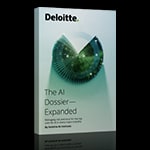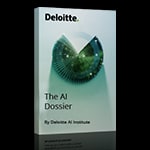Deloitte AI Institute
Top applications of AI in every major industry
Considerations for trustworthy AI and risk management
The AI Dossier
After decades as science fiction fantasy, artificial intelligence (AI) has made the leap to practical reality and is quickly becoming a competitive necessity. Yet, amidst the current frenzy of AI advancement and adoption, many leaders and decisionmakers still have significant questions about what AI can actually do for their businesses.
This dossier highlights dozens of the most compelling, business-ready use cases for AI across six major industries. Each use case features a summary of the key business issues and opportunities, how AI can help, and the benefits that are likely to be achieved. The dossier also includes several emerging AI use cases for each industry that are expected to have a major impact in the future.
Of course, the best uses for AI vary from one organization to the next, and there are many compelling use cases for AI beyond the ones highlighted here. However, reading through this collection should give you a much clearer sense of what AI is capable of achieving in a business context—now, and over the next several years—so you can make smart decisions about when, where, and how to deploy AI within your own organization (and how much time, money, and attention you should be investing in it today).


Consumer
Consumer
Encompassing a wide range of businesses including automotive, consumer products, retail, wholesale & distribution, transportation, hospitality & services, the industry has a strong and defining focus on serving customers – and a common set of current and future business issues they are trying to solve.
Learn more...
Energy, Resources & Industrials
Energy, Resources & Industrials
The main challenges to increased AI adoption and deployment largely revolve around data. To succeed with AI, ER&I companies should have strategies and roadmaps based on a practical understanding of what parts of the business are best suited for AI.
Learn more...
Financial Services
Financial Services
To increase adoption rates, the important next step is to stop dabbling with AI and start embracing and industrializing it so that AI solutions can be deployed on a large scale across the entire enterprise. Simply throwing more money at the problem won't be enough.
Learn more...
Government & Public Services
Government & Public Services
AI Adoption rates vary depending on the government agencies, their existing infrastructure's reliance on legacy systems, and workforce fluency. However, a common trend has emerged from the growing use of robotic process automation (RPA) to automate back-office activities.
Learn more...
Life Sciences & Health Care
Life Sciences & Health Care
Most health care and life sciences organizations have been primarily using AI to automate repetitive tasks and standard business processes. By combining AI technology with the fields of medicine and science, many are looking for opportunities to transform some of their most critical processes and achieve sustainable competitive advantage through AI.
Learn more...
Technology, Media & Telecommunications
Technology, Media & Telecommunications
Telecom companies tend to be the furthest along at embracing AI, thanks to the sector's longstanding focus on operational efficiency and customer acquisition/retention. Many technology companies have been slower to embrace AI, while others were born on AI. In the media sector, most of the focus on AI has been on personalizing content and customer engagement.
Learn more...Managing risk and trust for AI use cases
New technologies can present new risks, and in AI, identifying and managing risk can be particularly challenging. AI is still maturing as a technology, use cases are often novel, and every enterprise and industry contends with unique assets, goals, and business priorities. No matter that challenge, the stakes are high. AI outcomes can impact the quality of customer engagements, operational efficiency, brand reputation, compliance, cybersecurity, and more.
As a result, organizations deploying AI should consider where risks exist and take steps to promote the trustworthy application of AI. It begins with an understanding of the qualities of trust that are relevant to a use case. Deloitte's Trustworthy AI™ framework defines several dimensions:

Six ways that AI creates business value
Looking across all AI use cases, there are generally six major ways that AI can create value for a business:
- Cost reduction. Applying AI and intelligent automation solutions to automate tasks that are relatively low value and often repetitive, reducing costs through improved efficiency and quality. (Example: Automating data entry and patient appointment scheduling using natural language processing).
- Speed to execution. Reducing the time required to achieve operational and business results by minimizing latency. (Example: Accelerating the process of drug approval by using predictive insights to create a synthetic trial).
- Reduced complexity. Improving understanding and decision making through analytics that are more proactive, predictive, and able to see patterns in increasingly complex sources. (Example: Reducing factory downtime by predicting machinery maintenance needs).
- Transformed engagement. Changing the way people interact with technology, enabling businesses to engage with people on human terms rather than forcing humans to engage on machine terms. (Example: Using conversational bots that can understand and respond to customer sentiment to address customer needs more effectively).
- Fueled innovation. Redefining where to play and how to win by using AI to enable innovative new products, markets, and business models. (Example: Recommending new product concepts and features based on customer needs and preferences mined from social media).
- Fortified trust. Securing a business from risks such as fraud and cyber – improving quality and consistency while enabling greater transparency to enhance brand trust. (Example: Identifying and anticipating cyber attacks before they occur).
Make smarter decisions about when, where, and how to deploy AI
Organizations have the opportunity to unlock the full potential of AI when they embrace it and deploy it at scale throughout their enterprise.

AI is quickly becoming a competitive necessity for nearly all types of businesses – driving unprecedented levels of efficiency and performance and making it possible for businesses of every shape and size to do things that simply weren't possible before.
The key to success is to start small but think big. According to a recent Deloitte survey – State of AI in the Enterprise, 3rd Edition – 74% of businesses surveyed are still in the AI experimentation stage with a focus on modernizing their data for AI and building AI expertise through an assortment of siloed pilot programs and proofs-of-concept, but without a clear vision for how all the pieces fit together. By contrast, only 26 percent of businesses are focused on deploying high impact AI use cases at scale, which is when the real value kicks in
While AI adoption rates and maturity vary widely across industries, AI is driving new levels of efficiency and performance for businesses of all sizes.
Get in touch

Mike Canning
US Government & Public Services Industry Leader US Consulting Government & Public Services Industry Leader | Principal

Monica O'Reilly
US Financial Services Industry Leader US Risk & Financial Advisory Financial Services Industry Leader | Vice Chair

Kathryn Pavlovsky
US Risk & Financial Advisory Energy, Resources & Industrials Industry Leader | Principal

Paul Silverglate
US Risk & Financial Advisory Tech, Media & Telecommunications Industry Leader | Principal

Anthony Waelter
US Consumer Industry Leader US Risk & Financial Advisory Consumer Industry Leader | Principal

















